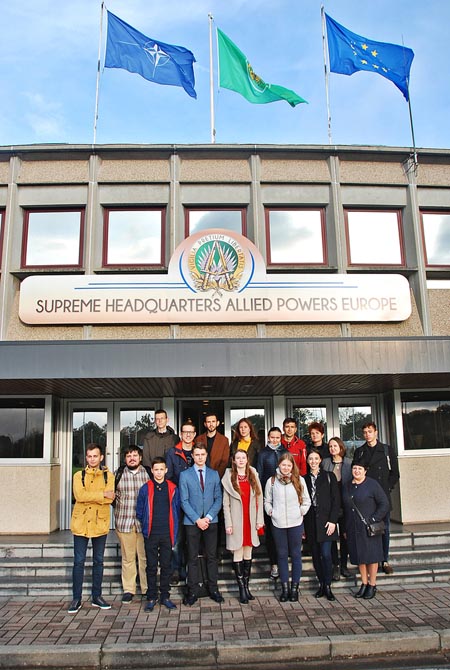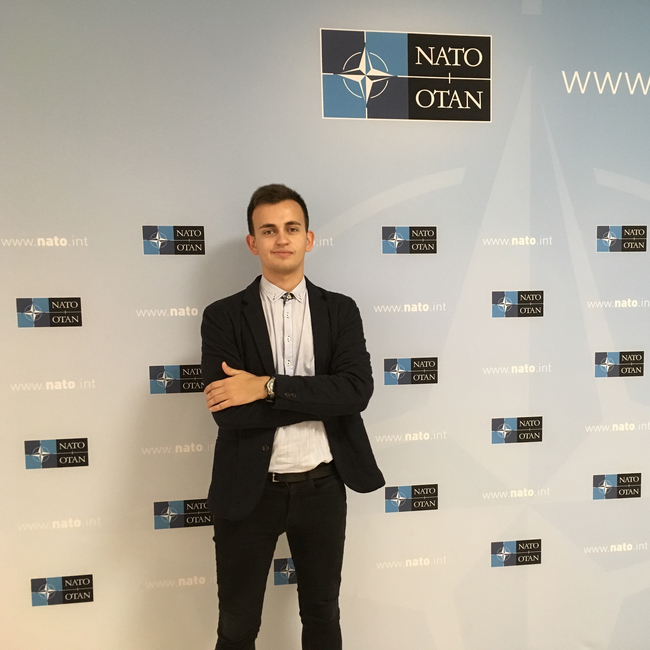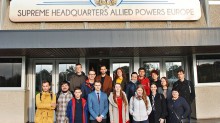In Brussels, you can be charmed with historic structures on Grand Place but still fail to understand why the city is sometimes built up so chaotically. Savoring Belgian waffles on the city’s narrow streets, you can shut your eyes to the fact that some people, who are very far from local values, are living outdoors here, in the capital of the European Union. You can, after all, visit the NATO Headquarters without reflecting too much on the future of Ukraine and the North Atlantic Alliance.
You can look at architectural monuments without seeing the essence of Brussels, listen to the unobtrusive hubbub of the city without hearing its voices. Below is the account of my attempt to see and hear Brussels.
IT IS JUST TIME TO SPEAK FRANKLY
I came to Belgium as part of a Ukrainian group on a fact-finding visit to the NATO Headquarters and the Supreme Headquarters Allied Powers Europe (SHAPE) near the city Mons. The visit was organized by the NATO Information and Documentation Center in Ukraine and the newspaper Den.
Visiting the top-security facilities of today’s most powerful military and political alliance provides a nice opportunity to put questions to its officials. But it is in reality not so simple a matter. NATO’s buildings and territories are minimalist and modest. NATO officials’ answers to thorny questions are traditionally restrained, often formal, and always fit in with the North Atlantic Alliance’s official position. Yet they must be asked.
Former foreign minister Volodymyr Ohryzko once told the Den Summer School of Journalism: “In my view, the EU and NATO are, figuratively speaking, two legs. The EU and NATO are the economic and the military-political bases, respectively. Unless we have this balance, we will remain lame.” Unfortunately, Ukraine remains lame in both legs, although it is gradually trying to buff them up. At least, thanks to one of the latest friendly gestures of the European Union, Ukrainians can stand firmly and without visas in the passport on the Belgian and other grounds previously separated by the “Schengen wall.”

There is, regrettably, less progress in the strategically important problem of NATO. We were told during a lecture on the North Atlantic Alliance’s values and principles about the so-called Noah’s rule by which NATO is guided: “predicting rain does not count, building arks does.” Yes, NATO member states have built a strong and safe ark which has to face more and more challenges, such as Russia’s hybrid war. Ukraine is using its modern-day experience to help improve this security system. Moreover, this country is paying a high price to protect NATO’s ark from the formidable Russian deluge. However, they are not exactly hurrying to throw a lifebuoy for us to reach the ark. But are we asking for one loudly and persistently enough?
Neither the pubic nor the authorities have always been sufficiently aware of the necessity of Ukraine’s NATO membership. Only the annexation of Crimea and the war in eastern Ukraine have at last clarified the situation for the majority of Ukrainians. NATO is a question of security. The Russian aggression has proved that the only security system that could stop it effectively is the North Atlantic Alliance.
It would seem that everybody should favor the course towards NATO now. Yes, sociological surveys show an essential increase of public support for the Alliance membership. However, Ukrainians still lack basic knowledge of the Alliance, particularly about the principles of its collective security mechanism. NATO remained a speculative issue for a long time in Ukraine. It was always manipulated, and the Ukrainian perception of the Alliance has been warped so much that some people still remain enthralled by numerous myths and stereotypes. This raises a question: is Ukraine really making enough efforts on this thorny path? For it is necessary to work not only on the military and diplomatic level, but also inside the country.
As far as pro-NATO information in concerned, Den/The Day is perhaps the only Ukrainian publication that has been covering systemically and consistently the Ukraine-NATO relations in the past two decades and arguing that our country should be a member of the North Atlantic Alliance. This period of time has also seen the activities of the NATO Information and Documentation Center which opened as far back as 1997, when the Charter on a Distinctive Partnership between Ukraine and NATO was signed.
We spoke very much at NATO Headquarters roundtables about NATO communication campaigns in Ukraine. Although these campaigns are not of too large a scale, they play a positive role. It is not exactly fair to blame the NATO Office in Ukraine. The blame lies, above all, with the Ukrainian leadership which never managed to pursue a course towards NATO in the years of independence, although this work was done under the guidance of statesman Yevhen Marchuk. Yet this chance was missed.

We should also defend our position clearly and convincingly in the dialog with the Alliance. Ukraine has been in the forefront of defending the entire Western civilization for four years now. So we need more aid. It is just time to speak frankly about Ukraine’s membership in NATO and the Membership Action Plan (MAP). Many NATO member states are afraid these steps will provoke a still more aggressive response from Russia. But in reality it is just the contrary: in 2008, when NATO did not give Ukraine and Georgia the MAP (Russia blocked this decision via Germany and France), it in fact encouraged Russian aggression against Georgia and let similar developments occur in Ukraine.
To err is human. It is only necessary to draw the right conclusions in order not to make the same mistakes again. It is Ukraine that should initiate a correction of past mistakes in the relationship with NATO.
“BRUSSELIZATION”
Now let us get back from the NATO Headquarters to the streets of Brussels. Whoever has visited the Belgian capital must have noticed its haphazard development: modern concrete and plate-glass structures often brazenly intrude into Gothic and baroque architecture. This phenomenon has even brought forth the term “Brusselization.” In urban planning, this term means chaotic commercial construction in the historical part of a city, when historical buildings are torn down uncontrollably to give way to modern ones. The term emerged during a mass-scale demolition of structures in Brussels’s historical part in the 1960s-1970s.
“Brusselization” changed the face of the Belgian capital, showing that not only natural calamities and wars are to blame for the destruction of historical urban landscapes. It is again about the importance of correcting mistakes which, however, always leave a trace. Since the 1990s onwards, the Brussels authorities have been gradually admitting their mistakes and drawing up a number of laws that protect historical monuments and green areas. The state also regularly allocates funds to the owners of buildings that have a historical, cultural, or esthetic value to keep up their appearance.
However, if you stop putting on the airs of a poker-faced fault-finding connoisseur of architectural ensembles, you will admit that Brussels, with its narrow streets, is in fact very cozy.
Brussels is the capital of the European Union. But this city does not look like as bustling megalopolis and, all the more so, one of the main centers of the whole EU. Yet the Europeans do not boast of excessive and ostensive grandeur. You can see this on every square meter.
The European Quarter is the unofficial name of the Brussels district, where most of the EU institutions that shape the policies and the future of the European community are located. Incidentally, there are similar quarters also in Luxembourg and Strasbourg. Modern architecture buffs will undoubtedly like this quarter.
Interestingly, just a few dozen meters away from the European Parliament, there is a park with a playground where children were playing basketball to the accompaniment of… a cackling gander. It is rather an irrational picture, taking into account that EU officials work close by. But that’s the way it was. And I think everything is right here – openly, modestly, without excessive isolation of administrative buildings from ordinary residents and guests of Brussels.
A CAPITAL OF CONTRASTS
Brussels is a thick cocktail of contrasts. It is not only about architecture. This city is diverse in everything. Foreigners account for more than a third of the local population, which is no wonder because institutions of the European Union, NATO, and other international organizations are located here. But there are not only a lot of foreign officials here.
What mars the cozy, even refined, atmosphere of downtown Brussels are the many improvised outdoor “settlements” of the non-European-looking homeless. Likewise, the uptown areas will unpleasantly surprise you with streets full of garbage.
The policies of official Brussels also often contrast with realities. On November 23, 2016, the European Parliament passed a resolution on countering Russian propaganda. Now, a year later, the informational mud of Russia Today continues to flow onto Europeans, judging by what I saw on television in my hotel room.
So, it is contrasts that help one make an integrated picture of Brussels as a city and as the capital of the European Union which has been known for decades for the unique ability to preserve unity in diversity. Yet, as new challenges have emerged, the foundation of this unity needs to be reinforced regularly.








